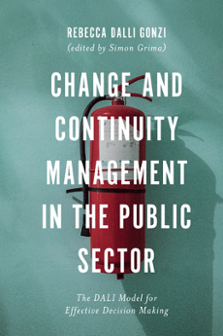
Index
Change and Continuity Management in the Public Sector: The DALI Model for Effective Decision-Making
ISBN: 978-1-78973-168-2, eISBN: 978-1-78973-167-5
Publication date: 24 April 2019
Citation
Gonzi, R.D. (2019), "Index", Grima, S. (Ed.) Change and Continuity Management in the Public Sector: The DALI Model for Effective Decision-Making, Emerald Publishing Limited, Leeds, pp. 143-149. https://doi.org/10.1108/978-1-78973-167-520191008
Publisher
:Emerald Publishing Limited
Copyright © 2019 Emerald Publishing Limited
INDEX
Note: page numbers in italic and bold refers to figures and tables respectively & page numbers followed by ‘n’ refers to endnotes.
- Prelims
- Chapter 1 Introduction: Setting a Standard for Service
- Chapter 2 Public Sector Responses to Radical Change: An Analysis of Theoretical Models
- Chapter 3 Public Sector Cases: Decision-making and Response
- Chapter 4 The Results
- Chapter 5 Conclusions and Reflections
- Appendix 1 Online Survey
- Appendix 2 Focus Group Discussions: Workshop-based Setting
- Bibliography
- Index